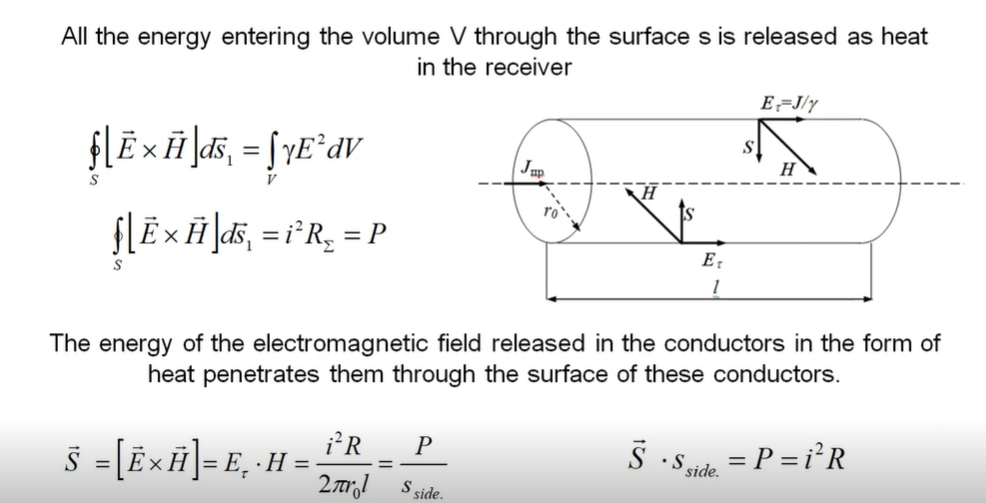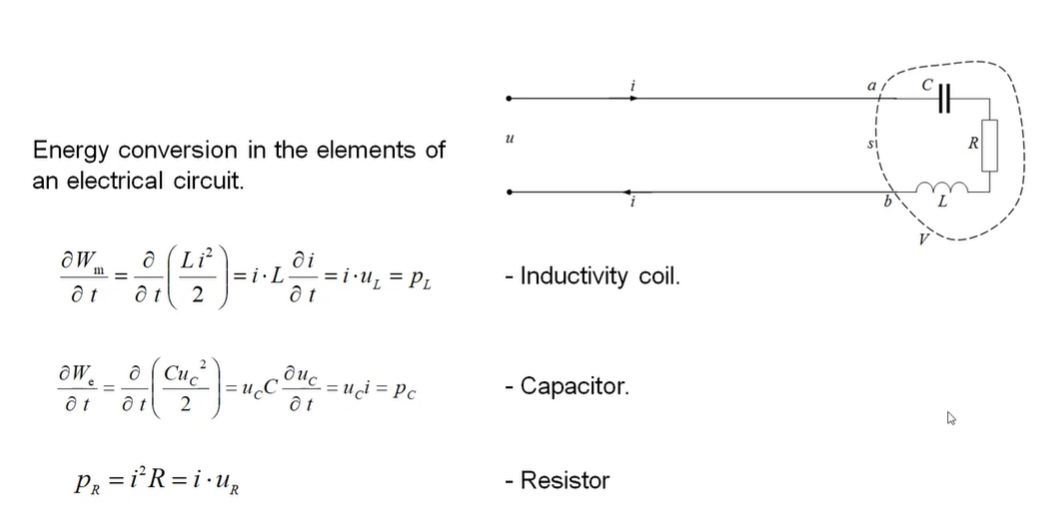
- •1. Electrostatic field. Coulomb’s law. Gauss law (Электростатическое поле. Закон Кулона. Закон Гаусса)
- •Variables and units
- •Coulomb’s Law. (ЗаконКулона)
- •Electric Field Strength e and Displacement Field d. (Напряжённостьисмещениеэлектрическогополя)
- •Gauss’ Law. (ЗаконГаусса)
- •2. Poisson’s and Laplace’s equations for the potential of electric field (Уравнения Пуассона и Лапласа для потенциала электрического поля) Electric Potential. (Электрический потенциал)
- •Poisson’s and Laplace’ s equations. (Уравнения Пуассона и Лапласа)
- •3. Electrostatic Energy (Электростатическая энергия) Electrostatic Energy (Электростатическаяэнергия)
- •Virtual experiment. (Эксперимент по нахождению энергии системы)
- •Consequences (Следствия)
- •4. Power and Joule’s Law (Энергия и закон Джоуля-Ленца)
- •5. Continuity Equation (Уравнения непрерывности) ContinuityEquation (Уравнение непрерывности)
- •Image method for the flat boundary between magnetic media (Метод изображений для плоской границы между магнитными носителями)
- •8. Static magnetic field. Biot–Savart’s Law. Ampere’s Law (Статическое магнитное поле. Закон Био–Савара. Закон Ампера)
- •Variables and units (Переменные и единицы измерения)
- •Main Relations (Основные соотношения)
- •Magnetic flux density (Индукция магнитного поля)
- •Biot-Savart’s law (Закон Био-Савара)
- •Ampere’s law (Закон полного тока)
- •The cut in the space (Разрез в пространстве)
- •Laplace equation for the scalar magnetic potential (Уравнение Лапласа для скалярного магнитного потенциала)
- •10. Vector magnetic potential. Inductance (Векторный магнитный потенциал. Индуктивность)
- •Vector magnetic potential (Векторный магнитный потенциал)
- •Magnetic flux (Магнитный поток)
- •Differential equation for the vector magnetic potential (Дифференциальное уравнение для векторного магнитного потенциала)
- •Gauging of the vector magnetic potential (Калибровка векторного магнитного потенциала)
- •Integral presentation of the vector magnetic potential (Интегральное представление векторного потенциала)
- •Inductance (Индуктивность)
- •Mutual inductance (Взаимная индуктивность)
- •Inductance of thin contours (Индуктивность тонких контуров)
- •12. Internal inductance of a thin conductor (Внутренняя индуктивность тонкого проводника) Flux linkage of a thin current layer (Потокосцепление тонкого слоя с током)
- •Internal inductance of a thin conductor (Внутренняя индуктивность тонкого проводника)
- •13. Inductance of a two wire transmission line (Индуктивность двухпроводной линии).
- •14. Variable separation method in a cylindrical coordinate system (Метод разделения переменных в цилиндрической системе координат). Application of Laplace’s equation (Применение уравнения Лапласа).
- •Angular function (Угловая функция)
- •Radial function (Радиальная функция)
- •General solution of the Laplace’s equation in a cylindrical coordinate system (Общее решение уравнения Лапласа в цилиндрической системе координат)
- •15. The Faraday’s law (Закон электромагнитной индукции).
- •Lenz’s Law (правило Ленца)
- •Induction by a temporal change of b (Индукция за счёт временного изменения b)
- •16. Induction through the motion of a conductor (Индукция за счет движения проводника).
- •17. Induction by simultaneous temporal change of b and motion of the conductor (Индукция одновременным изменением b во времени и движением проводника).
- •18. Unipolar generator (Униполярный генератор).
- •19. Hering’s paradox (Парадокс Геринга)
- •20. Diffusion of magnetic fields into conductors (Распространение электромагнитного поля в проводнике)
- •21. Periodic electromagnetic fields in conductors. (Периодическое электромагнитное поле в проводниках)
- •Penetration of the electromagnetic field into a conductor. (Проникновение электромагнитного поля в проводник)
- •The skin effect. (Скин-эффект)
- •22. Poynting theorem. (Теорема Пойнтинга) Electromagnetic Field Energy. (Энергия электромагнитного поля)
- •The rate of decrease of the electromagnetic field energy in a closed volume. (Скорость уменьшения энергии электромагнитного поля в замкнутом объёме)
- •Transmission of energy in a dc line (Передача энергии в линиях постоянного тока)
- •The field picture near the wires with current (Картина поля вблизи провода с током)
- •25. Energy flows in static electric and magnetic fields (Поток энергии в статических электрических и магнитных полях).
- •26. The reduced magnetic potential (Редуцированный магнитный потенциал). Reduced scalar magnetic potential (Редуцированный скалярный магнитный потенциал)
- •Combination of scalar magnetic potential and reduced magnetic potential (Комбинация скалярного магнитного потенциала и редуцированного магнитного потенциала)
- •27. Classification of numerical methods of the electromagnetic field modeling (Классификация численных методов моделирования электромагнитного поля).
- •Classification of the problems (Классификация проблем)
- •Classification of the methods (Классификация методов)
- •28. Method of moments
- •Discretization of the problem domain (Дискретизация проблемной области)
- •29. Basic principles of the finite element method.
- •30. Finite functions (Ограниченная функция – отлична от нуля только в пределах треугольника)
- •Simplex coordinates
- •Approximation of functions inside triangles (Аппроксимация функций внутри треугольника)
- •Approximation of the equation (Аппроксимация уравнения)
- •31. Weighted residual method (метод взвешенных невязок)
- •32. Weak formulation of the electromagnetic field modeling problem
- •33. Boundary conditions in electric and magnetic fields
- •1) First type boundary conditions
- •34. Main equations of electromagnetic field in integral form.
- •35. Main equations of electromagnetic field in differential form.
- •36. Electric field of a point charge (Электрическое поле точечного заряда)
- •37. Electric field of a uniformly charged sphere (Электрическое поле равномерно заряженной сферы)
- •38. Flat capacitor. Field. Surface charge. Capacity. (Плоский конденсатор. Поле. Поверхностный заряд. Вместимость.)
- •39.2 Inductance of a cylindrical coil with the rectangular cross section(Индуктивность цилиндрической катушки прямоугольного сечения).
- •4 0.1 Electric field induced by charged line placed above conducting surface (Электрическое поле, создаваемое заряженной линией, помещенной над проводящей поверхностью).
- •4 0.2. Magnetic field induced by the line with a current placed above a ferromagnetic surface with infinitely high magnetic permeability
Transmission of energy in a dc line (Передача энергии в линиях постоянного тока)

All the energy entering the volume V through the surface s is released as heat in the receiver. The energy of the electromagnetic field released in the conductor in the form of heat penetrates them through the surface of these conductor. In this case we shall not neglect the resistivity of the wires themselves like we have done in the previous case. In such a case when we shall consider only some part of the transmission line, only some sample. And we can say that the energy which is dissipated inside the wire should be exactly equal to the energy which crosses the area of the cylinder which is a part of the wire. The right part its energy that dissipated inside. It might be expressed as squared current and resistance of this part of the wire. Here we assume that the current is distributed uniformly of the cross section of this wire and this power losses should be identical to this:

Magnetic field, induced by the wire, circulate around this wire, the field intensity, if there is some voltage applied to this wire, may be split into two parts. One part is the field which is normal to the surface of this wire, and the component of electric field which is parallel to the wire. This component must exist because the Ohm’s Law here is Eτ is equal to J/γ and so we shall consider both vectors: H, just circulate around the surface, that’s why in this point it is directed like it shown here, and Eτ, and we can see that these two vectors initiate a flow of the energy just inside the wire. So, in such a case energy crosses the cylindrical border of this wire and enters and then disperse inside the wire, it is transformed to the several (наверное имеется в виду рассеивание на несколько энергий) energy. In principle, it is easy to find exact expression of these vectors if you transform these reflections into the formulas. S - the Poynting’s vector, is E cross H (S=E x H) they are normal to each other that’s why we can simply multiply H and Eτ. H is the field which is induced by very long wire its current I/(2πr) (r0 is a radius of this wire). I·R/l – is the resistance of the wire. I2·R is Power, 2π·r0·l is an area of this surface. So, finally we get relations which is – energy which crosses the surface of the wire is the energy which is dissipated inside the same wire.
24. Transmission of energy in 2-wire line loaded on a R-L-C circuit (передача энергии по 2-проводной линии, нагруженной RLC)
Transmission of energy in a DC line (Передача энергии в линиях постоянного тока)

Similar consideration may be made for the load which consists of resistor, capacitor, and inductance. We should simply split the total energy which crosses this surface into several parts.
First of them, ∂Wm/∂t, the energy of the magnetic field which crosses this area corresponds to the magnetic field which is induced by inductance and is equal to

In any time moment, this power should not be equal to zero, but if the inductivity coil is ideal, of course, this power integrated, for example, by period will be equal to zero in any case.
A similar consideration can be done for the capacitor. Finally, we shall come to the same conclusion – it’s equal to the power which correspond to the capacitor.
And from the previous consideration we can also conclude that power in the resistor which is dissipated here is equal to such a product.
Now, this energy comes to the load from the external electromagnetic field and may be expressed as integral over the surface from E cross H, ds.

It is ∂W/∂t and then plus the energy which is dissipated in resistors. The energy ∂W/∂t is dependence of the energy stored in the inductance and capacitor and it is equal i·uL + i·uC and also i·uR. We can transform this to i times sum of these voltages. It is power. Again, we can find out that energy that crosses this area is equal to the power, which now is not dissipation of the energy but the power of the energy transformation (into the heat, electric field, magnetic field). The power of the flow of electromagnetic energy entering the surface S is equal to the total power consumed in the circuit between ab terminals.
